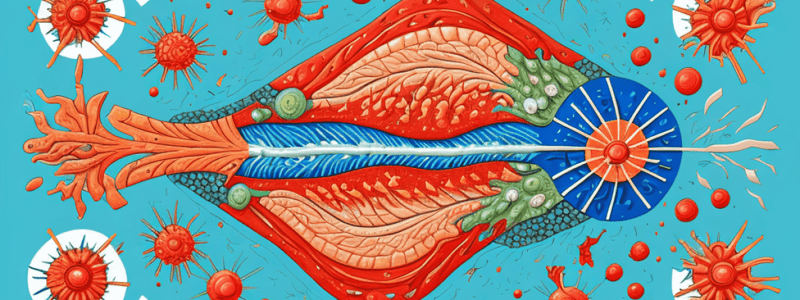Podcast
Questions and Answers
Which cells are dominant during the inflammation phase of wound healing?
Which cells are dominant during the inflammation phase of wound healing?
- Platelets
- PMNs (correct)
- Macrophages
- Lymphocytes
During the proliferation phase of wound healing, which cell type is responsible for depositing collagen and promoting neovascularization?
During the proliferation phase of wound healing, which cell type is responsible for depositing collagen and promoting neovascularization?
- Fibroblasts (correct)
- Lymphocytes
- Macrophages
- PMNs
What is the predominant cell type involved in the remodeling phase of wound healing?
What is the predominant cell type involved in the remodeling phase of wound healing?
- Fibroblasts (correct)
- Lymphocytes
- Macrophages
- Platelets
Which growth factor is associated with the inflammation phase of wound healing?
Which growth factor is associated with the inflammation phase of wound healing?
What occurs during the proliferation phase of wound healing?
What occurs during the proliferation phase of wound healing?
What is the net change in the amount of collagen during the remodeling phase of wound healing?
What is the net change in the amount of collagen during the remodeling phase of wound healing?
Which cell type is responsible for depositing collagen during wound healing?
Which cell type is responsible for depositing collagen during wound healing?
What is the primary function of macrophages during wound healing?
What is the primary function of macrophages during wound healing?
Which phase of wound healing involves epithelialization at a rate of 1-2 mm/day?
Which phase of wound healing involves epithelialization at a rate of 1-2 mm/day?
What is the order of arrival of cells in a wound according to recent research?
What is the order of arrival of cells in a wound according to recent research?
What is the rate of peripheral nerve regeneration during wound healing?
What is the rate of peripheral nerve regeneration during wound healing?
Which cell type is responsible for releasing TNF-alpha and IL-1 during the inflammation phase of wound healing?
Which cell type is responsible for releasing TNF-alpha and IL-1 during the inflammation phase of wound healing?
What type of protein is produced by fibroblasts and is chemotactic for macrophages?
What type of protein is produced by fibroblasts and is chemotactic for macrophages?
During which phase of wound healing is the platelet plug formed?
During which phase of wound healing is the platelet plug formed?
Which factor is most important for closed incisions and is dependent on collagen deposition and cross-linking?
Which factor is most important for closed incisions and is dependent on collagen deposition and cross-linking?
Which vitamin deficiency can lead to scurvy, impairing wound healing?
Which vitamin deficiency can lead to scurvy, impairing wound healing?
Which type of collagen is the most common in a healed wound?
Which type of collagen is the most common in a healed wound?
What is the crucial component for open wound healing (secondary intention)?
What is the crucial component for open wound healing (secondary intention)?
Which type of granules in platelets contain coagulation factors, PDGF, and TGF-beta?
Which type of granules in platelets contain coagulation factors, PDGF, and TGF-beta?
What type of suture closure may prevent infection?
What type of suture closure may prevent infection?
Which cells are involved in wound contraction and healing by secondary intention?
Which cells are involved in wound contraction and healing by secondary intention?
Flashcards are hidden until you start studying
Study Notes
- Fibronectin: protein produced by fibroblasts, chemotypeic for macrophages, anchors fibroblasts in the provisional matrix (mostly fibronectin and hyaluronic acid)
- Wound healing timeline: Days 0-2 dominated by PMNs, Days 3-4 by macrophages, Days 5 and on by fibroblasts
- Platelet plug: formed by platelets and fibrin during the hemostasis phase
- Epithelial integrity is crucial for open wound healing (secondary intention)
- Granulation tissue formation and secretion of proteins like collagen essential for wound healing
- Unepithelialized wounds can leak proteins and promote bacteria
- Tensile strength: most important factor for closed incisions (primary intention) dependant on collagen deposition and cross-linking
- Suture removal: 1 week for the face, 2 weeks for other areas, delayed primary closure may prevent infection
- Submucosa: strength layer of bowel, weakest time point for small bowel anastomosis is 3-5 days
- Myofibroblasts: smooth muscle cell–fibroblasts involved in wound contraction and healing by secondary intention communicate via gap junctions
- Collagen: several subtypes, Type I most common (primary collagen in a healed wound), Type III predominant during proliferation, collagen synthesis requires oxygen, vitamin C, zinc, and alpha-ketoglutarate
- Wound healing impairments: bacteria, devitalized tissue, cytotoxic drugs, diabetes, vitamin C deficiency (scurvy), steroids, wound ischemia, and disease-related conditions (e.g., Marfan's syndrome, osteogenesis imperfecta, Ehlers–Danlos syndrome, pyoderma gangrenosum)
- Platelet granules: alpha granules contain coagulation factors, platelet-derived growth factor (PDGF), and transforming growth factor beta (TGF-beta), beta-thrombomodulin binds thrombin, dense granules contain adenosine, serotonin, and calcium
- Platelet aggregation factors: TXA2, thrombin, platelet factor 4.
Studying That Suits You
Use AI to generate personalized quizzes and flashcards to suit your learning preferences.



